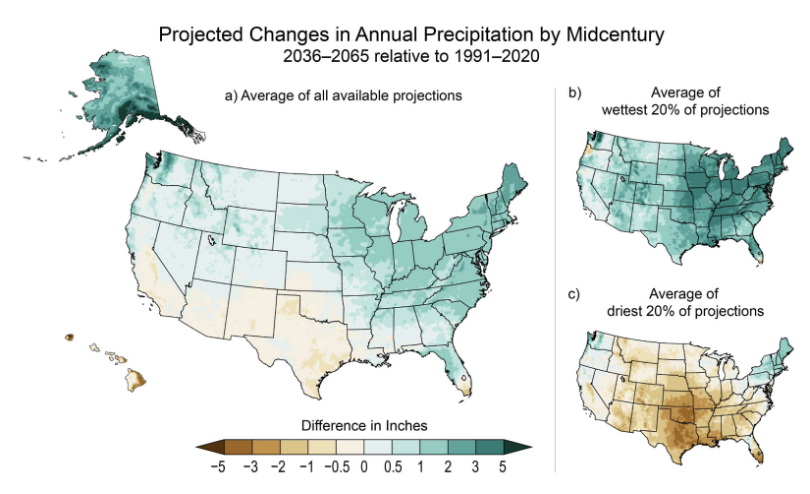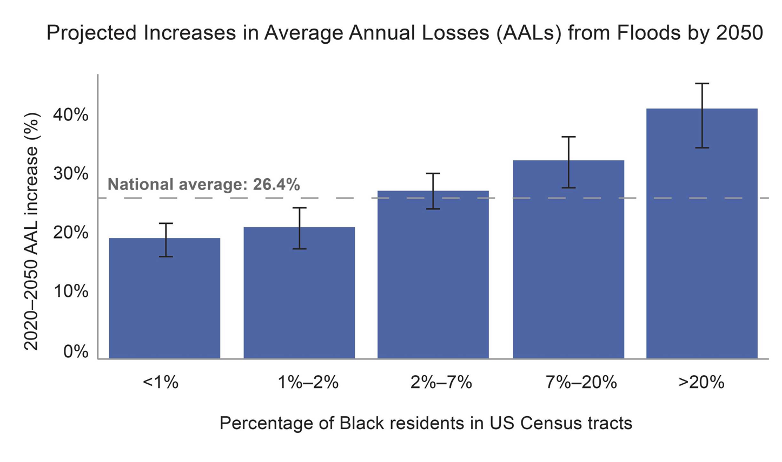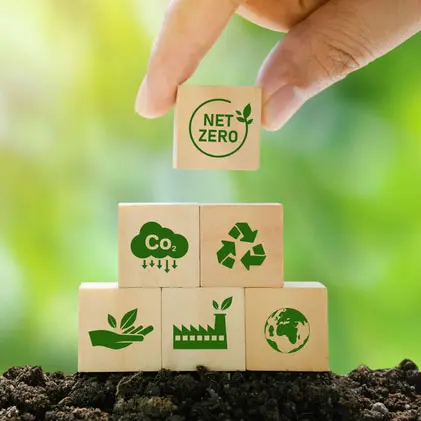Blog 2 in the Fifth National Climate Assessment Series
By Sarah Dobie, Ph.D., Lisa O’Fiesh, Sri Vedachalam, Ph.D., and Margo Davis
In November 2023, the U.S. Global Change Research Program unveiled the Fifth National Climate Assessment (NCA5). The report discusses the varied impacts of climate change on the water cycle and how this has impacted communities throughout the United States. In this blog post, we help to distill the report’s findings into two main insights and provide recommendations tailored to local governments and utilities to prepare the water sector for climate change.
Insight #1: Climate change is reshaping the water cycle
Climate change has had significant impacts on the water cycle; changes to global temperatures have altered the water natural cycle. While some areas experience a surge in precipitation—marked by increases ranging from 5-15 percent since 2002—others, including the Caribbean, Hawai‘i, and the southwest, grapple with dwindling water resources. In the Southwest, for instance, precipitation declined by over 15 percent during summer, fall, and spring, and by 10 to 15 percent during winter months.
Snowpack and glaciers, which are critical sources for freshwater in the Western United States, have also declined. Total snow water volume is expected to decrease by over 24 percent by 2050, which will threaten drinking water supplies and ecosystems reliant on rivers and streams fed by snowmelt.
These changes have contributed to a rise in water-related disasters, such as hurricanes, floods, wildfire, and drought. Water-related disasters are some of the most costly in the United States. Since 1980, the United States has experienced 342 water-related billion-dollar disasters, resulting in nearly $2.5 trillion in damages and over 15,000 deaths. This trend has accelerated in recent years, with a striking 17 percent of the economic losses from these disasters occurring from 2020 to 2022 alone.

Figure 1. Summary of projected changes in annual precipitation by Mid-Century under an intermediate (RCP4.5)scenario. Source: NCA5; credit: University of Colorado Boulder, NOAA NCEI, and CISESS NC.
Insight #2: Climate change is exacerbating water inequities
Approximately 2 million Americans currently do not have access to clean, safe drinking water and indoor plumbing to meet their basic needs. Millions of Americans also struggle to pay their water bills. A 2019 study found that low-income households spend an average of 12 percent of their disposable income on basic water and sewer costs. As droughts grow more severe and water supplies scarcer, these problems will only be amplified.
Studies show that water-related disasters also disproportionately impact underserved communities. For instance, Hispanic residents face a 50% higher likelihood of residing in 500-year floodplains compared to their White counterparts, while census tracts with higher proportions of Black residents confront a disproportionate increase in average annual flood losses.

Figure 2. Relationship between projected flood losses and race. Source: NCA5, Adapted from Wing et al., 2022
What can the water sector do to prepare for climate change?
Recommendation #1: Employ circular economy strategies to reduce GHG emissions and increase water resilience
The sustainability and resilience of the water sector depend heavily on other sectors, notably energy and food. To reduce GHG emissions and enhance resilience, it’s crucial for the water sector to collaborate with these sectors when devising solutions. For example, water utilities can contribute to GHG reduction through circular economy approaches like urine diversion for fertilizer production and utilizing biosolids in anaerobic digestion for biogas generation.
Recommendation #2: Leverage federal and state funding for water resilience infrastructure projects
Federal programs are investing billions in water infrastructure upgrades that local governments and utilities can leverage for increasing water sector resilience. For instance, the Bipartisan Infrastructure Law is investing $55 billion to expand access to drinking water for households, businesses, schools, and childcare centers – including funding for the Environmental Protection Agency’s (EPA’s) Clean Water State Revolving Loan Fund ($11.7 billion) and Drinking Water State Revolving Fund programs ($11.7 billion). For instance, Prince George’s County (MD) is using Clean Water Revolving Loan Funds to finance $350 million of green stormwater infrastructure to address flooding and stormwater pollution in the Chesapeake Bay watershed.
Recommendation #3: Use water infrastructure investments to address intersecting water challenges
The United States faces numerous challenges with its water infrastructure, stemming from aging systems, inadequate investment, mistrust, and increasing demands exacerbated by population growth and climate change. There are millions of US residents who mistrust tap water and rely on bottled water and other packaged beverages, furthering a cycle of disinvestment in our infrastructure. As communities invest in water resilience projects they have an opportunity to address these intersecting water challenges, and vice versa.



